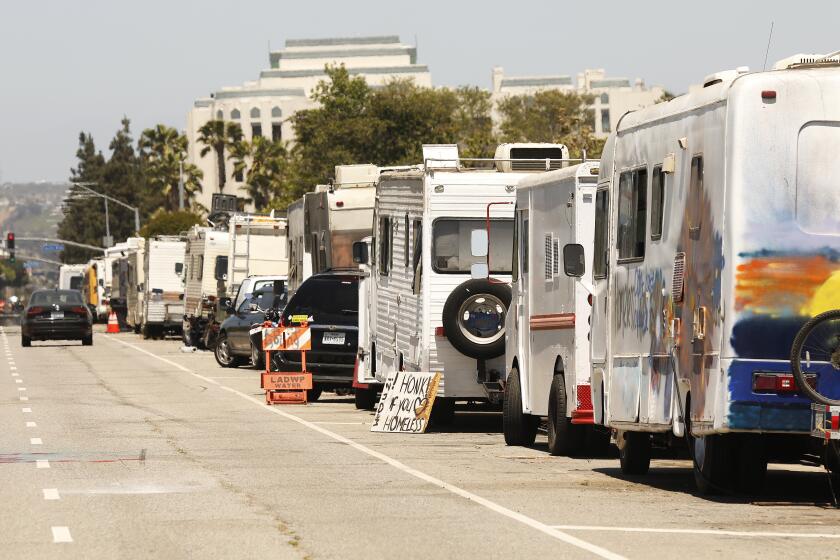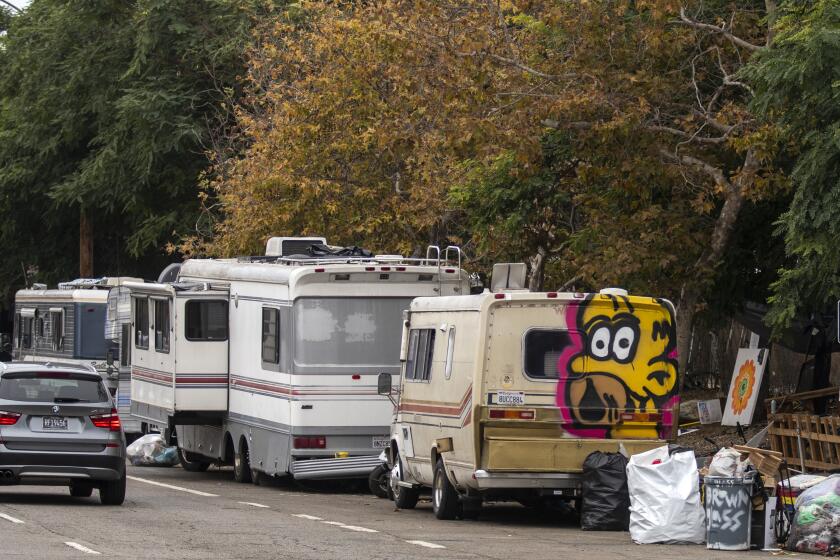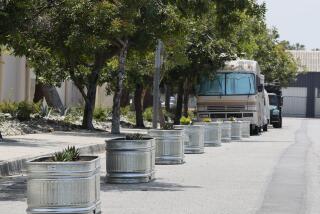Popular Boyle Heights jogging path blocked by RV dwellers; some residents complain
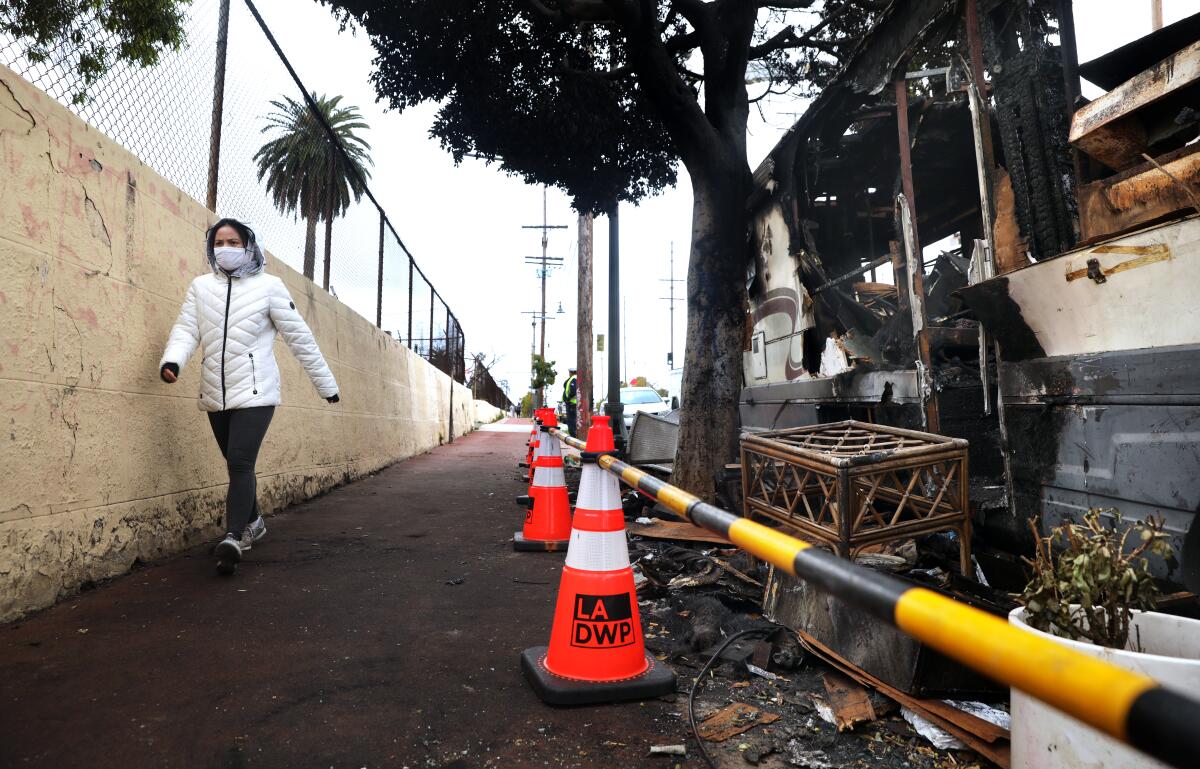
- Share via
As he walked briskly around Evergreen Cemetery in Boyle Heights, Tony Marquez used his cane to bat away empty soda and beer bottles.
Then, he reached the RVs parked next to the brick red, rubberized path.
Gardens planted next to the curb by RV residents, complete with fencing and planters, spilled onto the path, as did bicycles, power tools and appliances.
Marquez, 70, edged close to the cemetery wall as he stepped off the path and maneuvered around the obstacles.
A lifelong Boyle Heights resident, he has been walking the 1.4-mile loop every day since 2008, when he was diagnosed with arthritis in his right knee and needed a low-impact workout.
“You feel like you’re walking into someone else’s backyard instead of a public walkway,” said Marquez, a retired distributor of Sears catalogs and Verizon yellow pages, who is a member of the Boyle Heights Historical Society. “This used to be a great place for seniors to exercise, for friends to catch up, and now everything is cluttered and there’s so much trash. It’s sad.”
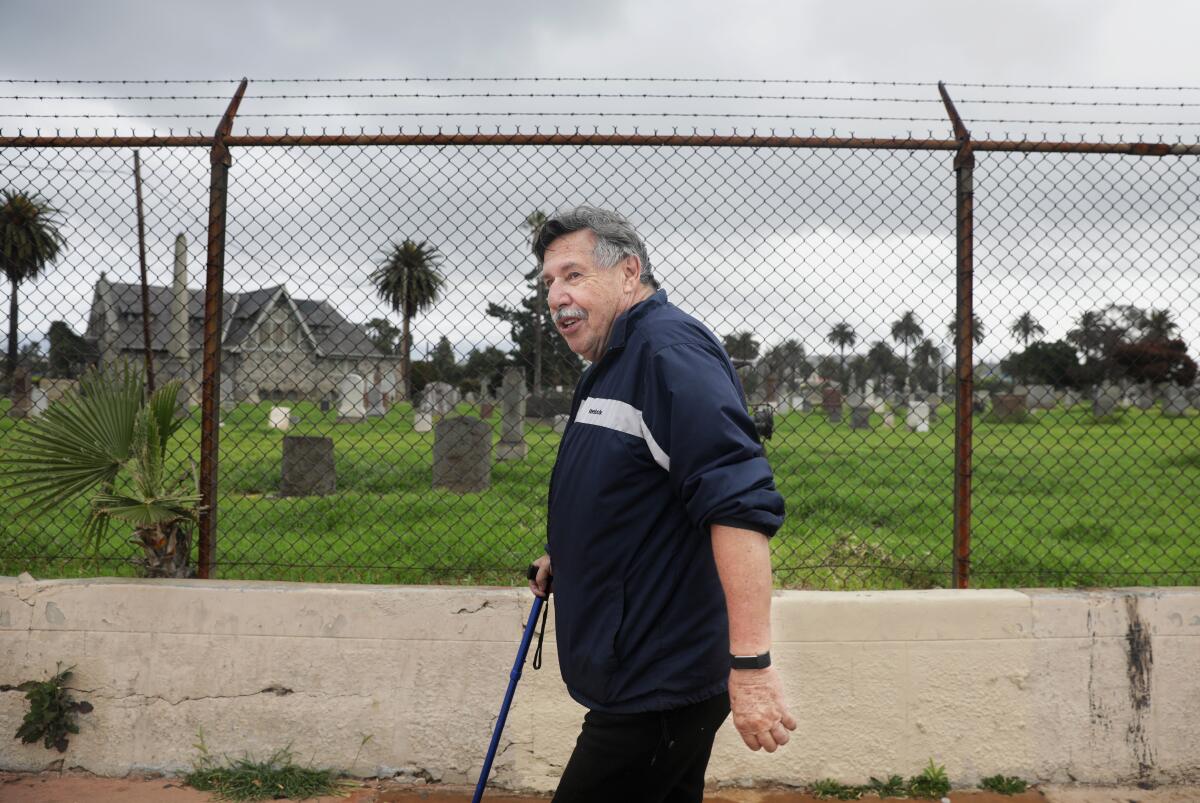
Marquez is among the residents calling for the motor homes to be removed from beside the jogging track, which has long been one of the few exercise options in an area that desperately needs them.
Some members of the Boyle Heights Neighborhood Council have reached out to the area city councilmember, Kevin de León, and Mayor Karen Bass’ office. They are also trying to come up with creative solutions, such as paid parking meters or a parking curfew.
Nadine Diaz, vice president of the neighborhood council, said the city does not enforce parking rules against the 20 or so RVs on North Lorena Street.
“There are never any fines or penalties, so of course they’re going to stay,” Diaz said. “It’s free.”
There aren’t enough trucks to tow or space to park large vehicles. But those issues pale in comparison to changing the mindset of many who live in RVs.
Some who live in the RVs say they try to be considerate and that the trash doesn’t come from them.
“None of them have spoken to us in the trailers,” said one RV dweller, Martha Batista. “Let them come in and see how clean we are. How can they throw us out without even talking to us?”
The route around the cemetery has been used by walkers and joggers since the 1940s. After Diaz and other residents formed the Evergreen Jogging Path Coalition and collaborated with then-Councilmember Nick Pacheco, the path opened in 2003 with the addition of decorative streetlamps and a rubberized surface.
It became popular with everyone from seasoned runners to grandmothers battling diabetes in a mostly Latino, working class neighborhood where obesity and other chronic health problems are common.
Joggers go to the track around L.A.’s Evergreen Cemetery for fitness and camaraderie. Maria Ruiz is drawing on both in a race against illness.
“When you look at rates of high cholesterol, diabetes, high blood pressure and obesity in Boyle Heights, we needed to provide a place where people could exercise,” said Diaz, who lives 100 yards from the path.
A stroll on the path has never been completely free of hazards. In 2005, the Times profiled a 58-year-old woman who carried a broken broomstick to ward off dangerous strangers.
Los Angeles Police Department Sgt. Guillermo Galvan, who is in charge of community relations at Hollenbeck Division, said that as long as the RVs are inhabited and not spilling sewage, law enforcement has little recourse.

“The solution here isn’t the police but the community,” Galvan said. “They’ll have to figure something out.”
The city’s transportation department can cite and tow inhabited RVs that create an environmental, public or traffic hazard but must first see if the resident will voluntarily move.
For those who insist on staying, parking officers will notify homelessness authorities to connect them with assistance.
The department received 51 calls from the public about abandoned vehicles near the cemetery last year and towed four, said spokesperson Colin Sweeney.
A few weeks ago, a Winnebago and a Volkswagen Jetta caught fire and were eventually towed away, Sweeney said.
Glass and debris shot onto the pathway, which was singed by flames that also ignited a nearby tree. Joggers with dogs detoured into the street so the broken glass wouldn’t cut the animals’ paws.
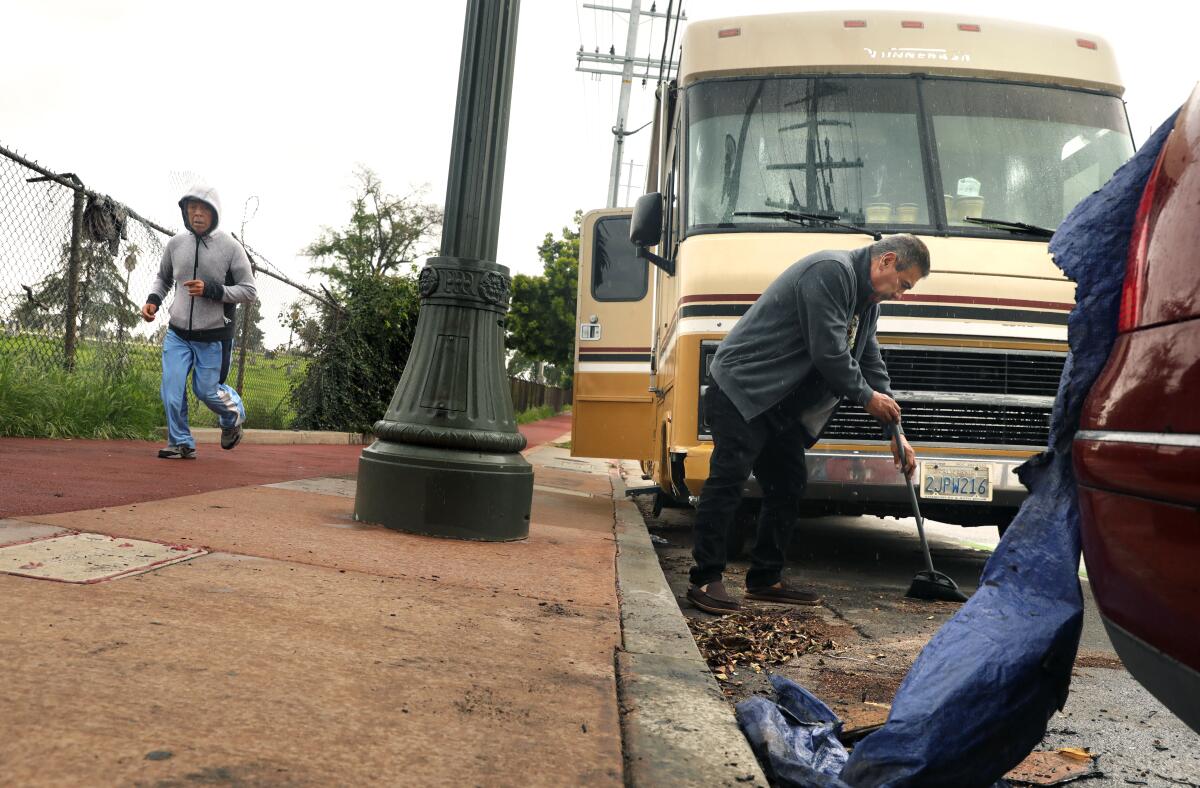
Gilbert Espinoza, who lives in an RV, said he helped clean up after the fire.
“This area is my home, and I like to keep it clean,” said Espinoza, 66, a retired mechanic who moved his RV to Boyle Heights three months ago to be closer to his brother. “Don’t let anyone tell you otherwise.”
Two years earlier, a fire chased Espinoza and his wife out of their one-bedroom Whittier apartment.
They stayed in hotels for a year, hoping to return, but after it was rebuilt, the apartment cost $300 more than before.
“We just couldn’t afford it,” said Espinoza, who lives on Social Security and disability payments. “It was too expensive to pay $75 a day for a hotel and too expensive to move back to where we lived.”
City officials voted to lift a moratorium on towing illegally parked campers, citing complaints from residents of human waste, drug use and trash.
Instead, Espinoza bought a motor home for $2,200. They first parked in Santa Fe Springs, moving after three months because they were fined by police.
They are now close to saving enough for move-in fees for an apartment.
“All I’m asking is for some patience, and we’ll get back on our feet,” he said. “Nobody wants to be here, but it’s not right to be thrown out.”
Batista, an unemployed waitress, has bounced around different neighborhoods in her RV since the home she rented in Westlake was sold to a developer in 2020. She has parked on North Lorena Street for more than a year.
Batista, 59, who is originally from Chihuahua, Mexico, said the trash on the path is mostly left by passersby, including customers from the nearby El Mercadito marketplace.
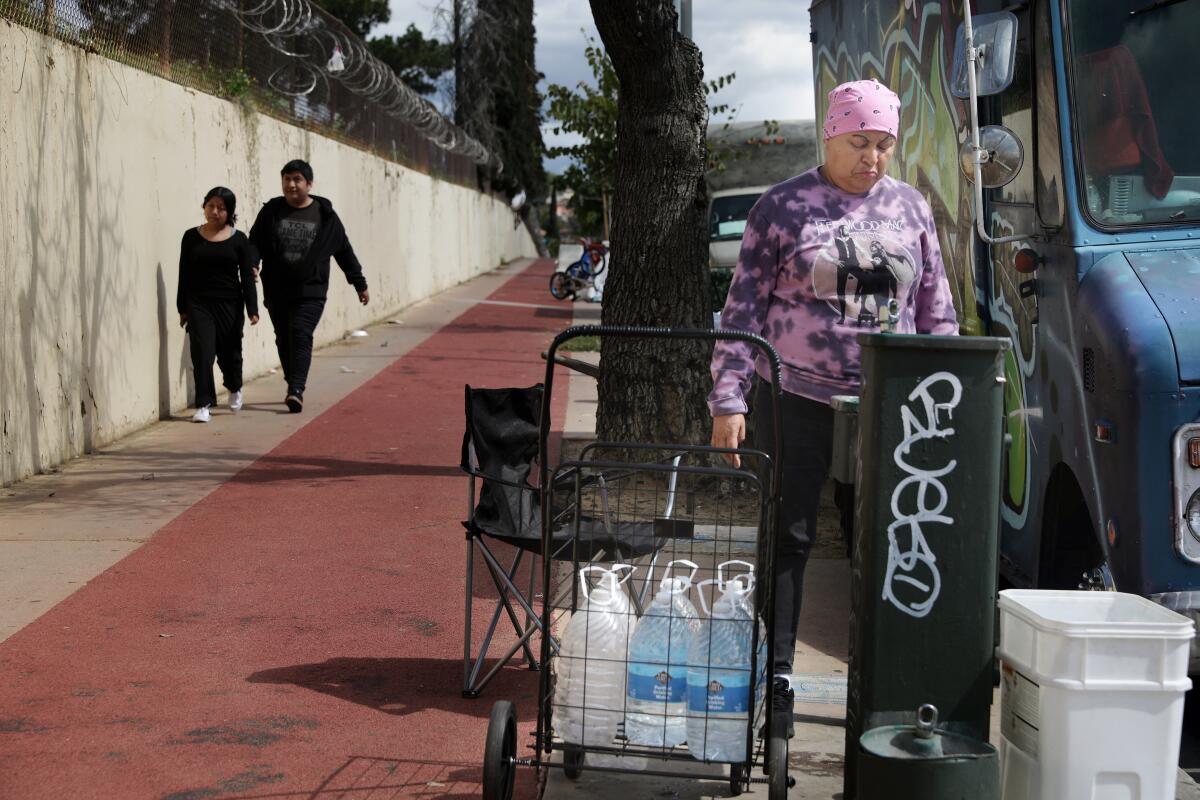
Residents sometimes dump mattresses, televisions and other broken appliances near the trailers, “knowing we’ll get blamed for the trash,” she said.
Pete Brown, a spokesperson for De León, said the streets surrounding the jogging path are cleaned weekly, while the path itself is cleaned at least twice a month.
The aging path needs to be resurfaced at some point, which could cost more than $2 million, according to Brown.
Brown said that the city doesn’t have a place to park RVs that are towed.
“I know some people want them gone, but you can’t just bully them out of town,” he said.
Diaz and Evergreen Jogging Path Coalition co-founder Diana Tarango, both fourth-generation Boyle Heights residents, said they are surveying locals and will discuss the issue at an upcoming neighborhood council meeting.
“We had to plan, organize and rally for this pathway over 20 years ago,” Tarango said. “If we have to do it again, we’ll do it again.”
More to Read
Sign up for Essential California
The most important California stories and recommendations in your inbox every morning.
You may occasionally receive promotional content from the Los Angeles Times.
